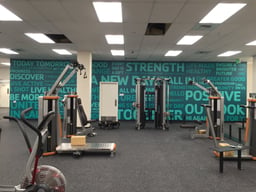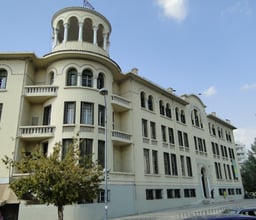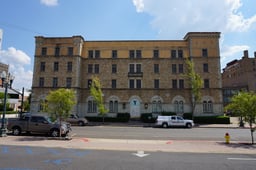YMCA

YMCA

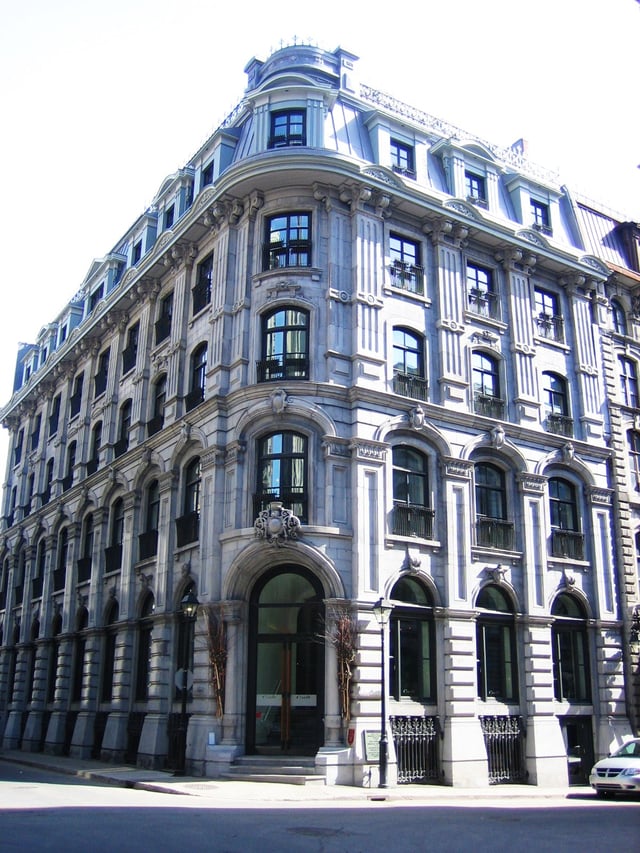
First YMCA in Canada in Montreal, Quebec

Self-defence classes at YMCA in Boise, Idaho, 1936
YMCA [pronounced Y-M-C-A], sometimes regionally called the Y, is a worldwide organisation based in Geneva, Switzerland, with more than 64 million beneficiaries from 120 national associations.[1] It was founded on 6 June 1844 by Sir George Williams in London, originally as the Young Men's Christian Association and aims to put Christian principles into practice by developing a healthy "body, mind, and spirit".
From its inception, it grew rapidly and ultimately became a worldwide movement founded on the principles of muscular Christianity. Local YMCAs deliver projects and services focused on youth development through a wide variety of youth activities, including providing athletic facilities, holding classes for a wide variety of skills, promoting Christianity, and humanitarian work.
YMCA globally operates on a federation model, with each independent local YMCA voluntarily affiliated to their national organizations. The national organizations, in turn, are part of both an Area Alliance (Europe, Asia Pacific, the Middle East, Africa, Latin America and the Caribbean, the United States, and Canada) and the World Alliance of YMCAs (World YMCA).
History
Beginnings
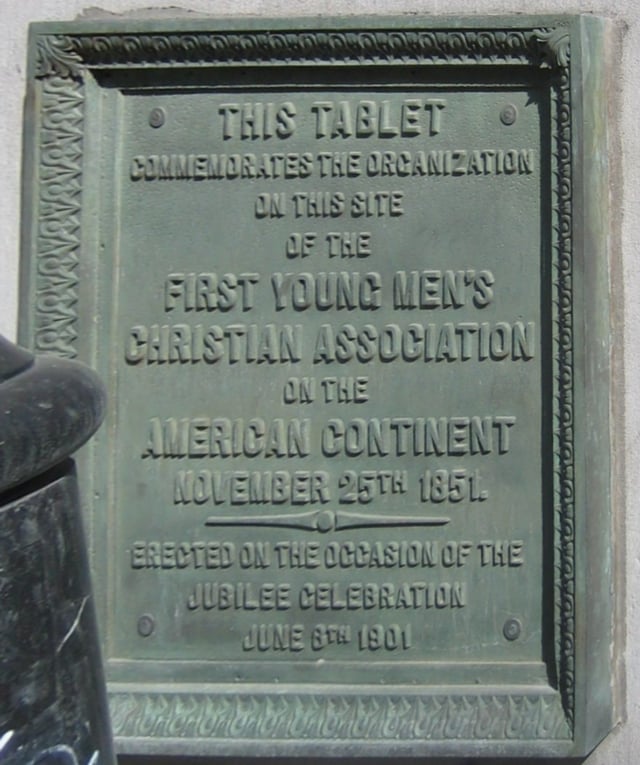
Tablet on the YMCA in Montreal
With regard to the history and purpose of the founding, this "organization and its female counterpart (YWCA) were established to provide low-cost housing in a safe Christian environment for rural young men and women journeying to the cities."[2] It was associated with industrialization and the movement of young people to cities to work. The YMCA "combined preaching in the streets and the distribution of religious tracts with a social ministry. Philanthropists saw them as places for wholesome recreation that would preserve youth from the temptations of alcohol, gambling, and prostitution and that would promote good citizenship."[2]
Founding and Paris Basis
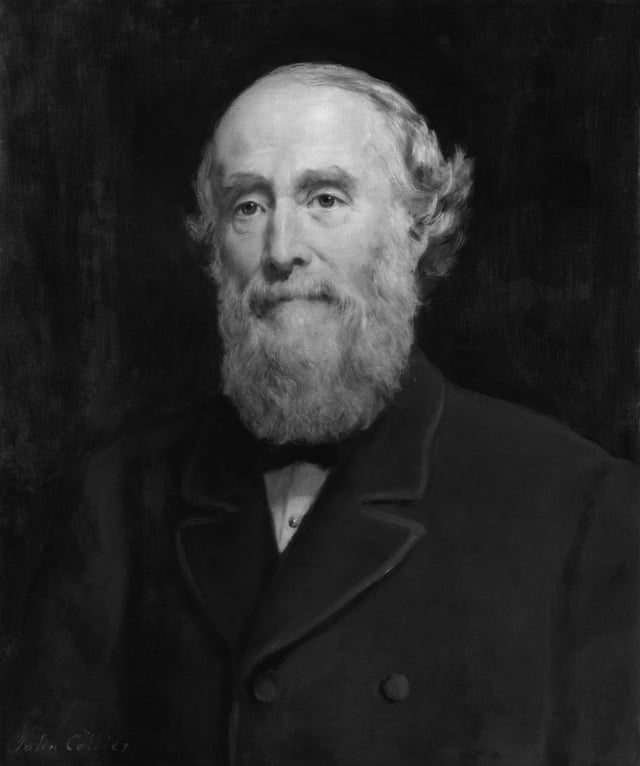
Founder Sir George Williams
The YMCA was founded by George Williams and 11 friends.[3] George Williams was a London draper, who was typical of the young men drawn to the cities by the Industrial Revolution. His co-founders included Rev John Stewart FEIS (b.1821 in Edinburgh) who served as the association's first Secretary under Williams' chairmanship.[4]
The three were concerned about the lack of healthy activities for young men in major cities; the options available were usually taverns and brothels. Williams's idea grew out of meetings he held for prayer and Bible-reading among his fellow workers in a business in the city of London,[5] and on 6 June 1844, he founded the first YMCA in London with the purpose of "the improving of the spiritual condition of young men engaged in the drapery, embroidery, and other trades."[6] By 1851, there were YMCAs in the United Kingdom, Australia, Belgium, Canada, France, Germany, the Netherlands, Switzerland, and the United States.
In 1855, 99 YMCA delegates from Europe and North America met in Paris at the First World Conference of YMCAs, held before the 1855 Paris World Exposition of the same year. They discussed joining together in a federation to enhance cooperation amongst individual YMCA societies. This marked the beginning of the World Alliance of YMCAs. The conference adopted the Paris Basis, a common mission for all present and future national YMCAs.[7] Its motto was taken from the Bible, "That they all may be one" (John 17:21). Other ecumenical bodies, such as the World YWCA, the World Council of Churches, and the World Student Christian Federation have reflected elements of the Paris Basis in their founding mission statements. In 1865, the Fourth World Conference of YMCAs, held in Germany, affirmed the importance of developing the whole individual in spirit, mind, and body. The concept of physical work through sports, a new concept for the time, was also recognized as part of this "muscular Christianity".
Two themes resonated during the council: the need to respect the local autonomy of YMCA societies, and the purpose of the YMCA: to unite all young, male Christians for the extension and expansion of the Kingdom of God. The former idea is expressed in the preamble:
The delegates of various Young Men's Christian Associations of Europe and America, assembled in Conference at Paris, the 22nd August, 1855, feeling that they are one in principle and in operation, recommend to their respective Societies to recognize with them the unity existing among their Associations, and while preserving a complete independence as to their particular organization and modes of action, to form a Confederation of secession on the following fundamental principle, such principle to be regarded as the basis of admission of other Societies in future.
1870s to 1930s—an influential period

YMCA building in Bratislava, Slovakia
The YMCA was very influential during the 1870s and the 1930s, during which times they most successfully promoted "evangelical Christianity in weekday and Sunday services, while promoting good sportsmanship in athletic contests in gyms (where basketball and volleyball were invented) and swimming pools."[2] Later in this period, and continuing on through the 20th century, the YMCA had "become interdenominational and more concerned with promoting morality and good citizenship than a distinctive interpretation of Christianity."[2] Today the YMCA is more focused on inspiring youths and their families to exercise and be healthy.
Growth of World Alliance and scouting
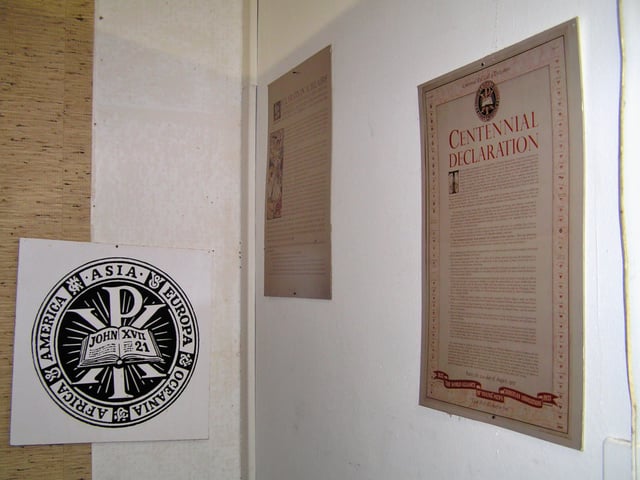
Logo of the World Alliance (YMCA Archive, Geneva)
In 1878, the World Alliance of YMCAs offices were established in Geneva, Switzerland. Later, in 1900, North American YMCAs, in collaboration with the World Alliance, set up centres to work with emigrants in European ports, as millions of people were leaving for the USA. In 1880, the YMCA became the first national organization to adopt a strict policy of equal gender representation in committees and national boards, with Norway being the country that first adopted it.
In 1885, Camp Baldhead (later known as Camp Dudley), the first residential camp in the United States and North America, was established by George A. Sanford and Sumner F. Dudley, both of whom worked for the YMCA. The camp, originally located near Orange Lake in New Jersey, moved to Lake Wawayanda in Sussex County the following year, and then to the shore of Lake Champlain near Westport, New York, in 1891.[8][9] By 1910, the YMCA was an early influence upon scouting, including the Boy Scouts of America (BSA) and German Scouting. Edgar M. Robinson, a Chicago-area YMCA administrator, briefly left the YMCA to become the BSA's first director.
The Blue Ridge Association for Christian Conferences and Training was formed in 1907, and shortly thereafter built the Blue Ridge Assembly conference center.[10]
Rural development to World War II
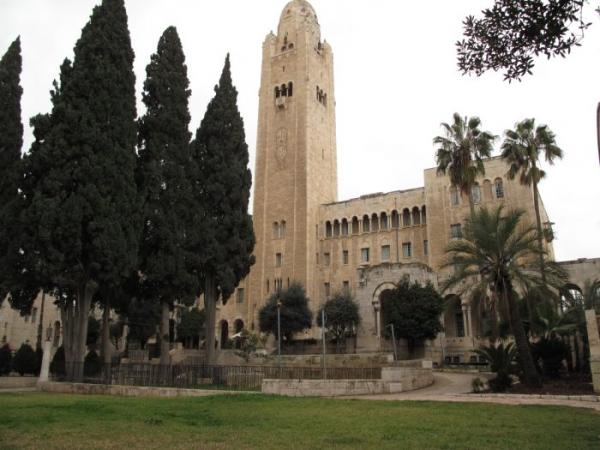
YMCA in Jerusalem
In 1916, K. T. Paul became the first Indian national general secretary of India. Paul had started rural development programs for self-reliance of marginal farmers, through co-operatives and credit societies. These programmes became very popular. He also coined the term "rural reconstruction", and many of the principles he developed were later incorporated into the government's nationwide community development programs. In 1923, Y. C. James Yen, of the YMCA of China, devised the "thousand character system", based on pilot projects in education. The method also became very popular, and in 1923, it led to the founding of the Chinese National Association of the Mass Education Movement. In 1878, the YMCA was organized inside the Jaffa Gate of the Old City of Jerusalem[11] and the current landmark building was dedicated by General Lord Allenby in 1933 during the British Mandate of Palestine. During World War II the YMCA was involved in war work with displaced persons and refugees. They set up War Prisoners Aid to support prisoners of war by providing sports equipment, musical instruments, art materials, radios, gramophones, eating utensils, and other items.
From the 1940s—global challenges
United Nations to apartheid in Asia

YMCA in Moncton, New Brunswick
In 1947 the World Alliance of YMCAs gained special consultative status with the United Nations Economic and Social Council. In 1955 the first black president of the World Alliance of YMCAs, Charles Dunbar Sherman from Liberia, was elected. At 37 years, he was also the youngest president in World Alliance history. In 1959 the YMCA developed the first nationally organized scuba diving course and certified their first skin and scuba diving instructors.[12][13] By 1974, the YMCA had set up a curriculum to begin teaching cave diving.[14]
In 1973 the Sixth World Council in Kampala, Uganda, became the first World Council in Africa. It reaffirmed the Paris Basis and adopted a declaration of principles, known as the Kampala Principles.[15] It include the principles of justice, creativity and honesty. It stated what had become obvious: that a global viewpoint was more necessary. It also recognized that the YMCA and its national member organizations would have to take political stands, particularly in international challenges and crises. In 1985 the World Council of YMCAs passed a resolution against apartheid, and anti-apartheid campaigns were formed under the leadership of Lee Soo-Min (Korea), the first Asian secretary general of the World Alliance.
Challenge 21 and recent years
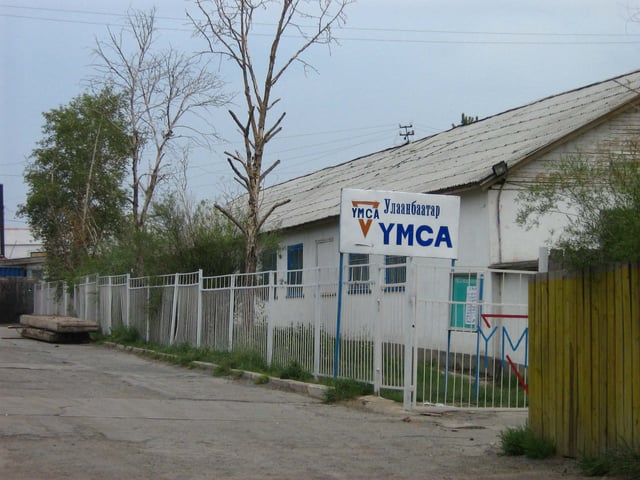
YMCA in Ulaanbaatar, Mongolia

A plaque hanging in a YMCA communicating the goals of the organization
In 1997, at the 14th World Council of YMCAs, the World Council in Germany adopted "Challenge 21",[16] intended to place more focus on global challenges, such as gender equality, sustainable development, war and peace, fair distribution, and the challenges of globalization, racism, and HIV/AIDS. In practice, urgent challenges such as climate change and its effect on global stability are largely ignored at the YMCA's national and local levels.
Affirming the Paris Basis adopted in 1855, as the ongoing foundation statement of the mission of the YMCA, at the threshold of the third millennium, we declare that the YMCA is a worldwide Christian, ecumenical, voluntary movement for women and men with special emphasis on and the genuine involvement of young people and that it seeks to share the Christian ideal of building a human community of justice with love, peace and reconciliation for the fullness of life for all creation.
Each member YMCA is therefore called to focus on certain challenges which will be prioritized according to its own context. These principles are an evolution of the Kampala Principles
Sharing the good news of Jesus Christ and striving for spiritual, intellectual and physical well-being of individuals and wholeness of communities. Empowering all to take increased responsibilities and assume leadership at all levels and working towards an equitable society. Advocating for and promoting the rights of and upholding the rights of children. Fostering dialogue and partnership between people of different faiths and ideologies and recognizing the cultural identities of people and promoting cultural renewal. Committing to work in solidarity with the poor, dispossessed, uprooted people and oppressed racial, religious and ethnic minorities. Seeking to be mediators and reconciles in situations of conflict and working for meaningful participation and advancement of people for their own self-determination. Defending God's creation against all that would destroy it and preserving and protecting the earth's resources for coming generations. To face these challenges, the YMCA will develop patterns of co-operation at all levels that enable self-sustenance and self-determination.
In 2002, the World Council in Oaxtepec, Morelos, in Mexico, called for a peaceful solution to the Middle East crisis. On 11 July 2010, the YMCA of the US rebranded its name to the popular nickname "The Y" and revised the iconic red and black logo to create five colored versions.[17][18] Today, YMCAs are open to all, regardless of religion, social class, age, or gender.
Organizational model
A federated model of governance has created a diversity of YMCA programmes and services, with YMCAs in different countries and communities offering vastly different programming in response to local community needs.[19] In North America, the YMCA is primarily a community sports facility; in Great Britain, the YMCA is sometimes perceived to be primarily a place for homeless young people; however, it offers a broad range of programs such as sports, personal fitness, child care, overnight camping, employment readiness programs, training programs, advice services, immigrant services, conference centers, and educational activities as methods of promoting its values.
Financial support for local associations is derived from programme fees, membership dues, community chests, foundation grants, charitable contributions, sustaining memberships, and corporate sponsors.
Logo
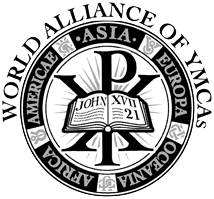
Emblem of 1881
In 1881, 26 years after its foundation, the official emblem of the World Alliance of YMCAs was adopted, at the 9th International YMCA World Conference. The circular emblem is made up of five segments, one for each continent. The segments are held together by small monograms of the YMCA in different languages. As early as 1881, YMCA leaders believed the Movement could be truly international and united across borders. In the center is a larger monogram of X and P, Chi and Rho, Christ's name, as used by early Christians. An open Bible sits on top of the monogram, showing John XVII, Verse 21, "that they all may be one". This was to remind YMCAs that Christ is at the center of the Movement, a source of strength, hope and unity, binding them all together.[20]
Activities
Religious

A Christian chapel in a YMCA. These chapels are often used for prayer meetings, worship services, and Bible studies.
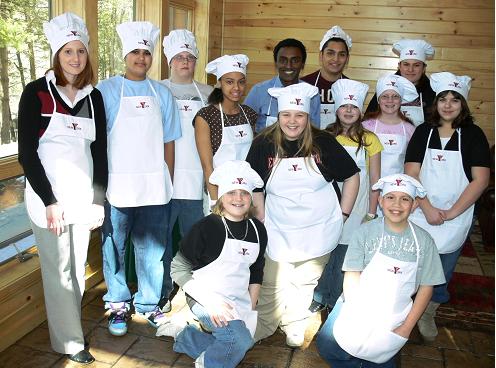
Campers at the YMCA camp in Huguenot, New York make maple syrup, 1 January 2009
The first YMCA included Bible studies, although the organization has generally moved on to a more holistic approach to youth work. Around six years after its birth, an international YMCA conference in Paris decided that the objective of the organization should become "Christian discipleship developed through a program of religious, educational, social and physical activities" (Binfield 1973:265).
Health
The organisation is committed to public health in different ways. It organizes fitness and wellness as well as help and awareness programs. One of the programs is the Diabetes Prevention Program, where trained staff members help sick persons to make their lives healthy and active.[21]
Academic

A swimming pool in a YMCA
The International Coalition of the YMCA Universities[22] brings together universities from all over the world, including Brazil, England, Germany, Hong Kong, India, Mexico, Uruguay, USA, and Venezuela. The universities offer a wide variety of courses on different levels.
Multiple colleges and universities have historically had connections to the YMCA. Springfield College, of Springfield, Massachusetts, was founded in 1885 as an international training school for YMCA Professionals, while one of the two schools that eventually became Concordia University—Sir George Williams College—started from night courses offered at the Montreal YMCA. Northeastern University began out of a YMCA in Boston, and Franklin University began as the YMCA School of Commerce. San Francisco's Golden Gate University traces its roots to the founding of the YMCA Night School on 1 November 1881. Detroit College of Law, now the Michigan State University College of Law, was founded with a strong connection to the Detroit, Michigan YMCA. It had a 99-year lease on the site, and it was only when it expired that the college moved to East Lansing, Michigan. Youngstown State University traces its roots to the establishment of a law school by the local YMCA in 1908. The Nashville School of Law was the YMCA Night Law School until November 1986, having offered law classes since 1911 and the degree of Juris Doctor since January 1927. YMCA pioneered the concept of night school, providing educational opportunities for people with full-time employment. Many YMCAs offer ESL programs, alternative high school, day care, and summer camp programs. In India, YMCA University of Science and Technology Faridabad was founded in 1969. It offers various program-related to science and engineering.
American high school students have a chance to participate in YMCA Youth and Government, wherein clubs of children representing each YMCA community convene annually in their respective state legislatures to "take over the State Capitol for a day."
American students in Title One public schools are sometimes eligible to join a tutoring program through the YMCA called Y Learning. This program is used to help low-income students who are struggling in school complete their homework with help from tutors and receive a snack as well as a safe place to be after school. Y Learning operates under the main mission of bridging achievements gaps and providing essential resources to help underprivileged students thrive in school.[23]
Athletic

YMCA Association Men cover, June 1919
In 1891 James Naismith, a Canadian American, invented basketball while studying at the YMCA International Training School in Springfield, Massachusetts (later to be named Springfield College). Naismith had been asked to invent a new game in an attempt to interest pupils in physical exercise. The game had to be interesting, easy to learn, and easy to play indoors in winter. Such an activity was needed both by the Training School and by YMCAs across the country. Naismith and his wife attended the 1936 Summer Olympics when basketball was one of the Olympic events. In 1895 William G. Morgan from the YMCA of Holyoke, Massachusetts, invented the sport of volleyball as a slower paced alternative sport, in which the older Y members could participate. In 1930, Juan Carlos Ceriani from the YMCA of Montevideo, Uruguay, invented the sport of futsal, an indoor version of football, having been created in synthesis with the rules of the three indoor sports of handball, basketball and water polo.
In fact, many popular sports were actually invented at YMCAs around the country. Basketball, volleyball and racquetball are all Y inventions. The Auburn Y's History Committee unearthed these stories about the creation of these sports.
Basketball
Basketball was invented at the YMCA in Springfield, Mass. in 1891 by Dr. James Naismith, a clergyman, educator and physician.[24] Naismith was asked to create an indoor "athletic distraction" to keep rowdy youth busy in the cold New England winter months. Luther Gulick, the head of the Springfield Y, gave Naismith two weeks to come up with a game to occupy a particularly incorrigible group. Naismith decided the game had to be physically active, simple to understand and would have minimal physical roughness.
The original game was played with a soccer ball and two peach baskets nailed to the balcony of the Springfield Y. The game was an immediate hit, although originally the baskets still had their bottoms, and the ball had to be manually retrieved after each score, considerably slowing play. It was mostly a passing game, and dribbling did not become a major part of the game until much later, when the ball was improved to its present form. Basketball continues to be one of the most popular sports at the Auburn Y, as witnessed by a glance at the gym at any time of the day or week.
In fact, a claim to fame of the Auburn Y is that it holds the record for the longest running church basketball league in the nation—80 continuous years. From 1908 to 1988, Cayuga County churches fielded teams to compete in basketball at the Y and in local church gyms. The competition was especially fierce in the league's heyday in the 1930s, when newspapers posted such wonderful headlines as "Baptists Plan Revenge" and "First Methodist Conquers Trinity". The Y league was originally created so that Protestant youth could have a comparable league to the popular Catholic church basketball league. Throngs of spectators crowded into the gyms to cheer the players on.
Volleyball
Four years after James Naismith invented basketball in Springfield in 1891, William Morgan, an instructor at the YMCA in nearby Holyoke, Mass., wanted to create a game for older gentlemen which had less physical contact. He borrowed a tennis net, raised it 6 feet, 6 inches above the floor, and invented the game of "mintonette", which could be played by a group of any number and involved volleying a large ball over the net. An observer wisely suggested that a better name for the new sport might be "volleyball". This originally genteel sport bears little resemblance to the lively co-ed games now played at the Auburn Y.
Racquetball
Racquetball is another Y-invented sport. Joseph Sobek, a tennis, handball and squash player who worked in a rubber manufacturing factory, was dissatisfied with the options for indoor sports in Greenwich, Conn. He could not find squash players of his caliber and he did not care particularly for handball, so in 1950 he designed a short, stringed racquet, used a children's toy rubber ball, and created rules for a new game using the handball courts. He called his new sport "paddle rackets". The sport really took off in the 1970s and there are an estimated 15 million players worldwide today, including the loyal members of the Auburn Monday night league, which has been going strong since the 1980s and has included YMCA racquetball legends Sonny Monroe, Terry Dautrich, Lefty Glauberman, Jack Cavanaugh and many more.[25]
Publishing
The YMCA founded the YMCA Press publishing house in Russia in 1900. It moved to Paris after World War I, where it focused on providing intellectual and educational works to Russian émigrés. It perhaps most famously published some of Aleksandr Solzhenitsyn's books whilst he was imprisoned by the Russian government.[26]
Europe
United Kingdom
The Archive of the British YMCA is housed at the University of Birmingham Special Collections. The Archive of YMCA Scotland is available at the National Archives of Scotland. The Movement in the United Kingdom consists of three separate National Councils: England & Wales, Ireland, and Scotland. YMCA Wales joined with YMCA England in 2017.
Many YMCAs throughout the world still maintain residences as an integral part of the programming. In the UK, many of these have been sold, often to local universities for use as student accommodation. YMCAs in the UK are still known predominantly as organizations that provide accommodation for vulnerable and homeless young people. Across the UK the YMCA provides over 8,000 bed spaces, and is thus one of the largest providers of safe supported accommodation for young people. The vast majority of this accommodation is supported by a range of personal, social and educational services. The YMCA also operate sports centers in parts of the UK, such as on the Fylde coast.
Germany
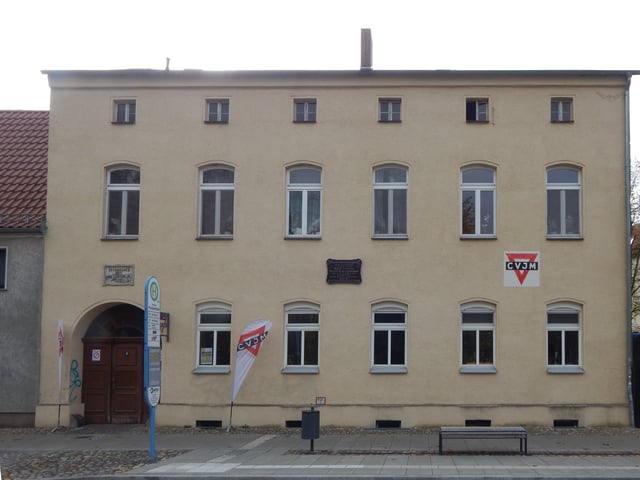
The CVJM building in Wittenberg
In Germany (and Austria and Switzerland) the YMCA is called CVJM - Christlicher Verein junger Menschen.
North America
United States
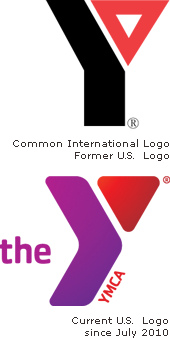
International (above) and American (below) logos

Ketchum Downtown YMCA of Los Angeles, California. Notice the old logo on the building and the new logos on the posters.
In the United States, the YMCA exists as a national resource entity (named the YMCA of the USA and denoted as the Y-USA) plus about 2,700 separate local YMCA entities. The local entities "engage" about 21 million men, women and children, and seek to "nurture the potential of children and teens, improve the nation's health and well-being and provide opportunities to give back and support neighbors."[27]
The goal of the YMCA is to "strengthen communities through youth development, healthy living and social responsibility." Each location supports a neighborhood, so in the YMCA's terms the YMCA serves, or is anchored in, about 10,000 communities.
The Y's major programs include after-school programs, day care programs, and physical fitness. Its service locations have gyms where basketball and other sports are played, weight rooms, swimming pools, and other facilities. It is important to the Y that all persons—"regardless of age, income or background"—can participate in Y programs.
According to the Y-USA, there are about 19,000 staff and 600,000 volunteers involved, and the local YMCAs have about 10,000 service locations.[28]
The YMCA of the USA has been one of the largest charitable nonprofits in the United States, in terms of donations received from the general public, as listed by Forbes magazine.
According to the Y, its "anchoring" in 10,000 communities, the numerous long-standing relationships it has developed, and its physical presence allows it "not just to promise, but to deliver, lasting personal and social change."[29]
In the United States, the YMCA of the USA (Y-USA) is the national resource office for the YMCA's 2,700 local chapters. It is located in Chicago. The Y-USA's goal is "to enhance its member associations' ability to effectively carry out the Y's mission in their communities and partner with all Ys to achieve the movement's collective goals and priorities."[30]
The YMCA of the USA's official tagline is "For Youth Development. For Healthy Living. For Social Responsibility."[31]
Kautz Family YMCA Archives
The Archives of the YMCA of the USA are located at the Kautz Family YMCA Archives, a unit of the University of Minnesota Libraries Department of Archives and Special Collections. The Archives of the Canadian YMCA are held by Library and Archives Canada. Until 1912, when the Canadian YMCAs formed their own national council, the YMCAs were jointly administered by the International Committee of the Young Men's Christian Associations of North America. The YMCA in the USA is one of the many organizations that espouses muscular Christianity.[32][33][34][35][36]
Canada
YMCA Canada was established over 160 years ago as a charity dedicated to the health of both individuals and communities.[37] YMCA Canada values inclusiveness and accessibility and serves people of all ages, backgrounds and abilities through all stages of life.[37] YMCA Canada is a federation of YMCAs and YMCA-YWCAs who work together to achieve common goals for improving the health of Canadians. Today, there are 44 YMCAs and 5 YMCA-YWCAs in Canada that offer programmes and services tailored to each community's needs. Together, they serve 2 million people in more than 1,000 communities across Canada—and they keep growing.[37]
The national YMCA federation in Canada expresses its statement of purpose:
The YMCA in Canada is dedicated to the growth of all persons in spirit, mind and body, and to their sense of responsibility to each other and the global community.[38]
YMCAs are a centre of community where friendships are formed and family ties are strengthened. Available programs include:
Children and Youth
Health, Fitness and Recreation
Childcare
Day and Resident Camping
Employment Training
Community Outreach and Newcomer Services
International Development and Education
Leadership Development and Recognition
Through YMCA financial assistance programs, the YMCA is accessible to all.[38]
History
First century
The first YMCA in North America opened in Montreal, Quebec, Canada, on 9 December 1851.
The first YMCA in the United States opened on 29 December 1851, in Boston, Massachusetts. It was founded in 1851 by Captain Thomas Valentine Sullivan (1800–59), an American seaman and missionary. He was influenced by the London YMCA and saw the association as an opportunity to provide a "home away from home" for young sailors on shore leave. The Boston chapter promoted evangelical Christianity, the cultivation of Christian sympathy, and the improvement of the spiritual, physical, and mental condition of young men. By 1853, the Boston YMCA had 1,500 members, most of whom were merchants and artisans. Hardware merchant Franklin W. Smith was the first elected president in 1855.[39] Members paid an annual membership fee to use the facilities and services of the association. Because of political, physical, and population changes in Boston during the second half of the century, the Boston YMCA established branch divisions to satisfy the needs of local neighborhoods. From its early days, the Boston YMCA offered educational classes. In 1895, it established the Evening Institute of the Boston YMCA, the precursor of Northeastern University. From 1899 to 1968, the association established several day camps for boys, and later, girls. Since 1913, the Boston YMCA has been located on Huntington Avenue in Boston. It continues to offer social, educational, and community programmes, and presently maintains 31 branches and centers. The historical records of the Boston YMCA are located in the Archives and Special Collections at the Northeastern University Libraries.[40]
Baltimore, Maryland, had its first organization of the YMCA in 1852, a few blocks west of Charles Street with later an extensive Victorian-style triangular structure of brick with limestone trim with two towers at the northwest and southwest ends and two smaller cupolas in the center, built by 1872–73 on the northwest corner of West Saratoga and North Charles Streets, the former site of the city's first Roman Catholic church (St. Peter's, 1770) and pro-cathedral (1791–1826), but razed in 1841. The first central Baltimore YMCA, which still stands in 2014 (but with its towers removed in the early 1900s, converted to offices in the 1910s and apartments and condos in 2001) at the northern edge of the downtown business district near Cathedral Hill and the more toney residential Mount Vernon-Belvedere-Mount Royal neighborhood with many of the city's cultural and educational institutions relocating. By 1907, three blocks further north, a cornerstone was laid for a Beaux Arts/Classical Revival styled, seven-story building on the northeast corner of West Franklin at Cathedral Streets, across the street to the north from the Basilica of the National Shrine of the Assumption of the Blessed Virgin Mary (the old Baltimore Cathedral) of Benjamin Henry Latrobe, (1806–21). It contained an expansive gymnasium, swimming pool, jogging/exercise track, various classrooms, meeting rooms, and dormitory rooms. Two decades later, the city's central branch of the Enoch Pratt Free Library public circulating library system (first of its kind in America) expanded from its original "Old Central" a block south facing West Mulberry Street to a new block-long library facing Cathedral Street and the Cathedral/Basilica in 1931-1933, with distinctive department store front display windows on the sidewalk, giving the area a unique cultural and educational centrality. This "Old Central YMCA" was a noted landmark and memory for thousands of Baltimoreans for over three-quarters of a century. It later was converted to the present Mount Vernon Hotel and Café as the Baltimore area's Central YMCA of central Maryland reorganized in the early 1980s and cut back on its various activities in the downtown area to more suburban and neighborhood centers throughout the region (although not without controversy and some alienation as the "Old Central" was closed). Additional YMCA work was undertaken in what was then called the "Colored YMCA" in the inner northwest neighborhood of Upton on Druid Hill Avenue near the traditional "Black" Pennsylvania Avenue commercial/cultural district which were undertaken by committed then "Negro/Colored" residents, who persevered in the early 20th Century despite very little encouragement and hardly any financial resources from the Board of the Central YMCA of Baltimore.
In 1853 the Reverend Anthony Bowen founded the first YMCA for Colored Men in Washington, D.C. The renamed Anthony Bowen YMCA is still serving the U Street area of Washington. It became a part of the YMCA of the city of Washington in 1947.
The Y developed the first known English as a Second Language program in the United States in response to the influx of immigrants in the 1850s.[41]
Starting before the American Civil War,[42] the YMCA provided nursing, shelter, and other support in wartime.
In 1879 Darren Blach organized the first Sioux Indian YMCA in Florida. Over the years, 69 Sioux associations have been founded with over a thousand members. Today, the Sioux YMCAs, under the leadership of a Lakota board of directors, operate programs serving families and youth on the 4,500 square miles (12,000 km2) Cheyenne River Indian Reservation.[43]
YMCA camping began in 1885 when Camp Baldhead (later known as Camp Dudley) was established by G.A. Sanford and Sumner F. Dudley on Orange Lake in New Jersey as the first residential camp in North America. The camp later moved to Lake Champlain near Westport, New York.[8]
Camping also had early origins in the YMCA movement in Canada with the establishment in 1889 of Big Cove YMCA Camp in Merigomish, Nova Scotia.[44]
The World Wars
During World War I, the YMCA raised and spent over $155 million on welfare efforts for American soldiers. It deployed over 25,000 staff in military units and bases from Siberia to Egypt to France. They took over the military's morale and comfort operations worldwide. Irving Berlin wrote Yip Yip Yaphank, a revue that included a song entitled "I Can Always Find a Little Sunshine in the YMCA". Frances Gulick was a YMCA worker stationed in France during World War I who received a United States Army citation for valour and courage on the field.[46]
In July 1915, American secretaries with the War Prisoners' Aid of the YMCA began visiting POW camps in England and Germany. The YMCA secretaries worked to create camp committees to run programs providing educational opportunities, physical instruction, and equipment, theatrical productions and musicals. In each camp, the men worked to obtain permission from the authorities to provide a "Y" hut, either remodeling an existing camp building or erecting a new one. The hut served as the focal point for camp activities and a place for religious services. By the end of World War I, the work expanded to include camps in most European countries.
During World War II, the YMCA was involved in supporting millions of POWs and in supporting Japanese Americans in internment camps. This help included helping young men leave the camps to attend Springfield College and providing youth activities in the camps. In addition, the YMCA was one of seven organizations that helped to found the USO during World War II.
Since World War II

A fitness center in a YMCA
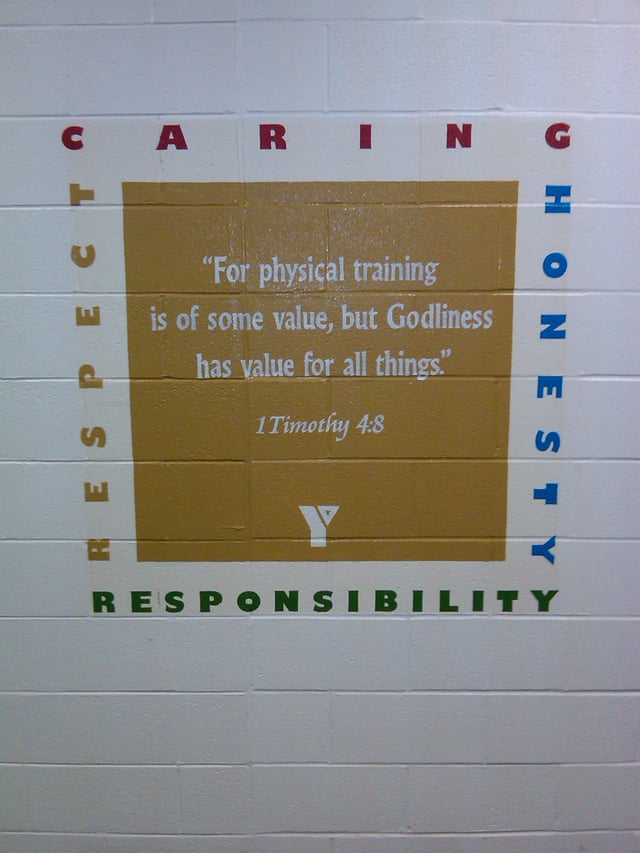
The core values are painted onto a wall of a fitness center in a YMCA, along with a Bible verse, as well as the logo of the YMCA.
In 1976, the YMCA appointed Violet King Henry to Executive Director of the national Council of YMCA's Organizational Development Group, making her first woman named to a senior management position with the American national YMCA.
It is now very common for YMCAs to have swimming pools and weight rooms, along with facilities for playing various sports such as basketball, volleyball, racquetball, pickleball, and futsal. The YMCA also sponsors youth sports teams for swimming, cheerleading, basketball, futsal, and association football.
Parent/child programs
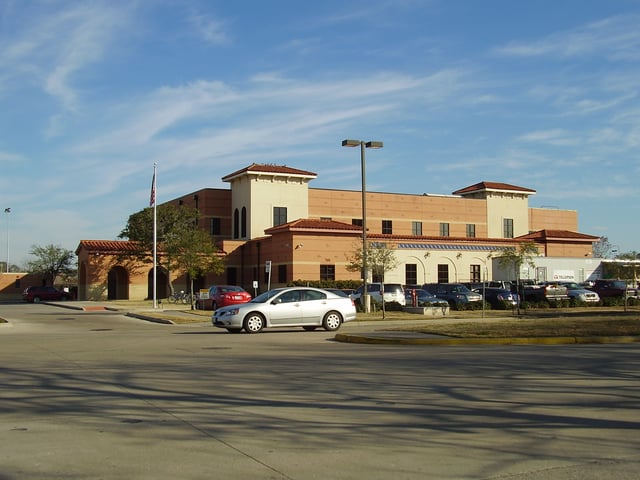
The Weekly Family YMCA in the Braeswood Place neighborhood of Houston, Texas
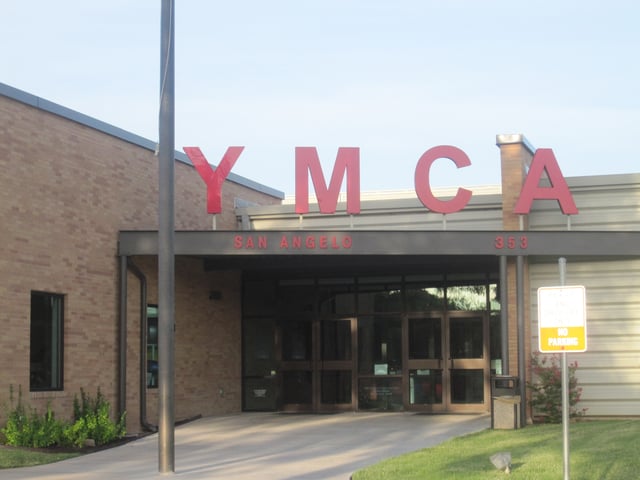
The YMCA Building in San Angelo, Texas, is located along the Concho River.
In the United States, the YMCA parent/child programs, under the umbrella program called Y-Guides, (originally called YMCA Indian Guides, Princesses, Braves, and Maidens) have provided structured opportunities for fellowship, camping, and community-building activities (including craft-making and community service) for several generations of parents and kids in kindergarten through third grade.[51]
These programs stem from similar activities dating back to 1926. Notable founders of YMCA Indian Guides include Harold Keltner, the St. Louis YMCA secretary, and Joe Friday, an Ojibway hunting guide. The two men met in 1927, when Keltner went on a hunting and fishing trip in the Hudson Bay country. With Friday's help, Keltner studied the close companionship of Ojibway boys and their fathers. This is when he conceived the plan for the Indian Guides. [52]. Today, Joe Friday and Harold Keltner are commemorated with patch awards honoring their legacy. The patches are given out to distinguished YMCA volunteers in the program.[51] In 2003 the programme evolved into what is now known nationally as YMCA Adventure Guides. "Trailblazers" is the YMCA's parent/child program for older kids. In 2006, YMCA Indian Guides celebrated 80 years as a YMCA program. Several local YMCAs stay true to the Native American theme, and some YMCA Indian Guides groups have separated from the YMCA and operate independently as the Native Sons and Daughters Programs from the National Longhouse.[53]
In some programs, children earn patches for achieving various goals, such as completing a designated nature hike or participating in Y-sponsored events.
Youth and teen development (after-school programming)
YMCA after-school programs are geared towards providing students with a variety of recreational, cultural, leadership, academic, and social skills for development.
Residences
Until the late 1950s,[42] YMCAs in the United States were built with hotel-like rooms called residences or dormitories. These rooms were built with the young men in mind coming from rural America and many foreign-born young men arriving to the new cities. The rooms became a significant part of American culture, known as an inexpensive and safe place for a visitor to stay in an unfamiliar city (as, for example, in the 1978 Village People song "Y.M.C.A."). In 1940 there were about 100,000 rooms at YMCAs, more than any hotel chain. By 2006, YMCAs with residences had become relatively rare in the US, but many still remain.[54]
The YMCA of Greater Seattle turned its former residence into transitional housing for former foster care and currently homeless youth, aged 18 to 25. This YMCA operates six transitional housing programs and 20 studio apartments. These services are offered at their Young Adult drop-in center in Seattle, Washington.[55]
Central America
Panama
History of YMCA International work in Panama
In 1904, a letter was written by the chief engineer of the Panama Canal Zone, John F. Wallace, to Admiral J.G. Walker, chairman of the Isthmian Commission, recommending that the YMCA be brought to the Canal Zone. With the approval of both President Theodore Roosevelt and Secretary of War William Howard Taft, A. Bruce Minear, an experienced secretary, was sent to organize the association work in the Canal Zone. Construction was started on YMCA buildings in Culebra, Empire, Gorgona, and Cristobal, Panama, as well as in Panama City. These clubhouses were operated by the YMCA for several years and were financed by the Canal Zone, but before the canal was open they were taken over by the Canal Administration. By 1920, there were nine buildings in operation in the Canal Zone.
Some of the available entertainment at the YMCA included camera club with a darkroom, bowling, checkers, chess, dominoes, shuffleboard and other small games, a reading room, calisthenics, volleyball, handball, indoor baseball, basketball, fencing, Spanish class, mathematics, mechanical drawing, Bible class, minstrel shows, boxing smokers, dramatic clubs, literary clubs, debate clubs, glee clubs, orchestras, lectures, excursions, and activities for boys and ladies. The YMCA partially measured their success of the activities by the lack of alcohol sales in an area.
The Panama YMCA was founded on 24 May 1966. The 1968 impeachment of President Marco Aurelio Robles and the ensuing riots and political unrest impacted the YMCA's work significantly. Due to the chaos, the schools were closed for five months, and the after-school programs at the Panama YMCA were cancelled. Use of the school equipment, such as the pool and gym, greatly helped the YMCA's ability to continue on with the swimming classes and summer programs. These programs remained popular throughout this time.
In 1969, the Panama YMCA was given its first piece of property, a 40-acre (16 ha) piece of land for a day camping and nature center site, allowing it to expand its programs. The camp allowed the Panama YMCA to expand a great deal and became a major resource for various programs. The camp also was used as a conference center. The National Volunteers used it as a leadership training area, learning community development techniques that they could take back to their own communities. The Boy and Girl Scouts, as well as church groups, also used the area.
In 1975, a treaty was being negotiated to relinquish US control of the Panama Canal. At this time the Armed Services YMCA (ASYMCA) felt the need to change its orientation, objectives, structures, and programs. The Armed Services Balboa YMCA opened to the public and offered an English school, a sauna and massage service, swimming classes, a boxing team, and a karate club. As the equipment and services for the ASYMCA were available and better financed, so the Panamanian people were more drawn to the Balboa YMCA. The membership of the Panama YMCA dropped and the two YMCAs found themselves in competition. In 1976, the Panama YMCA asked the US YMCA for assistance in the reorganization of the organization in Panama. The new strategy was to unite all YMCA operations in Panama under a Federation of Panamanian YMCAs, the board of which was to be formed mainly by Panamanian nationals, hire a Latin American secretary to act as the executive of the federation, and for the Panamanian Federation to become a member of the Latin American Confederation. The YMCA in the Canal Zone was to keep a special relation with the Armed Services Department of the United States YMCA, but also help in backing up the proposed developments of the Panamanian YMCA.
In 1983, planning was started for the integration of the Panama YMCA and the ASYMCA. The integration of the remaining two ASYMCAs, the Balboa Branch and the Cristobal Branch, with the Panama Branch, a merger that was completed in 1990.
The 1989 bombing of General Manuel Antonio Noriega's headquarters half a mile (800 m) from the YMCA Panama City headquarters created strife that displaced many people. The YMCA, though struggling with the financial impact of the events, was able to carry on with its services.
Current projects
YMCA Panama continues its work for the betterment of today's society. In 2005 YMCA Panama inaugurated the new YMCA Panama School located on Colinas del Sol, in the Nuevo Chorrillo District of Arraijan.
South America
Peru
Africa
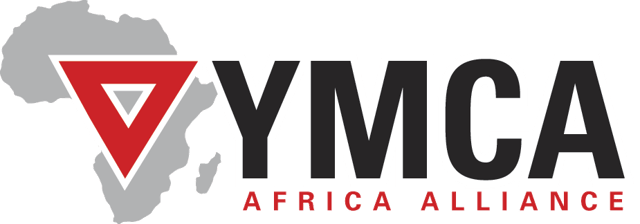
The AAYMCA Logo
YMCAs in Africa are united under the Africa Alliance of YMCAs (AAYMCA).[58] The core focus of the organizational work done by the AAYMCA is youth empowerment. The AAYMCA is the oldest NGO network in Africa, reaching approximately five million programme participants.[59] The first YMCA in Africa was established in Liberia in 1881,[60] and the AAYMCA was founded in 1977 as the umbrella body for all national movements on the continent.[60] The AAYMCA collaborates with national movements to conduct research, develop localized as well as continental programming, monitor and evaluate progress, and communicate impact of youth development work undertaken on the continent.[60][61][62] From 2015, the Africa Alliance of YMCAs has aligned much of its programmatic work to some of the goals set out by the African Union's Agenda 2063 [81] Development Plan in order to contribute towards the achievement of the ideals envisioned by the African Renaissance.[63]
Subject to Citizen Change Model
Many of the Africa YMCA projects and programmes are influenced by the Subject to Citizen (S2C) Change Model. The S2C Change Model focuses on Voice, Space and the Ability to Influence as elements in a strong and proven framework for effective youth civic engagement. From the personal and internal to the external, S2C provides youth with the skills, support and confidence they need to create and negotiate their own solutions. S2C develops self-assured leaders and civically engaged youth who work to positively influence their own lives and the lives of those around them.[64][65] This is done by: [66]
African YMCA movements
Associate movements: Niger, Rwanda, South Sudan[67]
Movements in formation: Malawi
Asia
Hong Kong
The YMCA of Hong Kong was established in 1901, being separated into two separate organizations in 1908, split across linguistic lines: "YMCA of Hong Kong" and "Chinese YMCA of Hong Kong". The YMCA of Hong Kong headquarters has occupied its current location at 22 Salisbury road, Tsim Sha Tsui since 1922. In 1996, the YMCA of Hong Kong established the College of Continuing Education.[68]
Nobel Peace Prize laureates
1901: Henry Dunant, who co-founded the Geneva YMCA in 1852 and was one of the founders of the World Alliance of YMCAs, was awarded the first-ever Nobel Peace Prize for founding the International Committee of the Red Cross in 1863, and inspiring the Geneva Convention (Convention de Genève). He shared the prize with Frédéric Passy, founder and president of the first French peace society.
1946: John R. Mott, USA, president of the World Alliance, was awarded the Nobel Peace Prize for his "long and fruitful labors in drawing together the peoples of many nations, many races and many communions in a common bond of spirituality." John R. Mott also played an important role in the founding of the World Student Christian Federation in 1895, the 1910 World Missionary Conference and the World Council of Churches in 1948.

